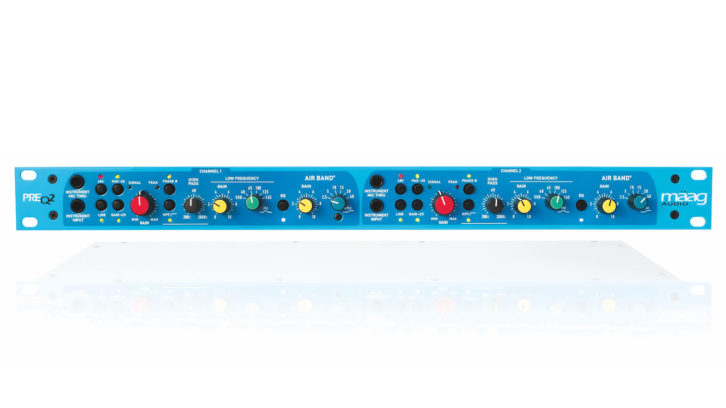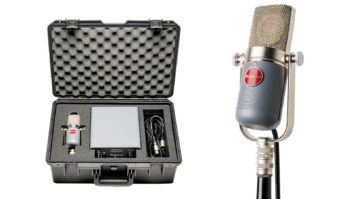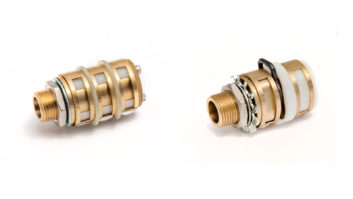
Mäag Audio’s PREQ2 Dual Mic Preamp With EQ is a professional dual channel strip useful for either recording or mixing. Made in the USA, the all-analog PREQ2 has two identical channels side-by-side in a 1U chassis with an internal world power supply. It also includes Cliff Mäag’s popular Air Band shelving equalizer, introduced in 1993 with the NTI EQ3.
The PREQ2 also incorporates many of the same features, specifications and performance characteristics of the company’s top-of-the-line EQ4M stereo mastering equalizer. Because of its classic design, a minimal phase shift equalizer, component quality and high-voltage power supply, the EQ4M has garnered significant praise as “the most musical-sounding equalizer ever made.”
The two matched channels of the PREQ2 will handle either line or microphone signal levels, with separate rear panel line-level input and microphone XLR connectors. The rear panel also has XLR output connectors for each channel, plus an IEC on/off/fuse mains switch. I took a look inside the all-steel cabinet and saw Wima capacitors used throughout, two large nickel-core Mäag Audio MA02 transformers and a low-profile toroidal AC power transformer.
Construction is first-class and beautifully laid out on a single circuit board using mostly surface mount devices. There are THAT Corp line-input receivers and line drivers (op amps) in sockets, and three-terminal regulators—one for the 48-volt phantom and two for the 18-volt +/- rails, all with proper heat sinks.
The switches used in the PREQ2 have different-colored LEDs to confirm their operation, and all controls have detents with the exception of the custom-made variable microphone input gain control. Subminiature relays are used for switching polarity on the output XLRs, the -20dB microphone attenuator pad, and between the mic XLR and the unbalanced 1/4-inch TS Instrument inputs.
MIC INPUT, LINE INPUT
The Mäag Audio PREQ2 microphone preamp section has up to 71 dB of total gain by way of a discrete Class-A (FET) transistor preamp that offers clean, detailed sound with +27 dBu of headroom and an EIN noise level of -128 dB. Two optimized gain ranges are selectable from the front panel—+20 dB to +42 dB, and +42 to +71 dB—using the front panel’s 25 dB gain switch. Maximum mic input level without using the 20 dB attenuator is +8 dB.
The microphone input section has front panel switches for +48-volt phantom powering, -20 dB attenuation pad, +25 dB gain, green signal present LED, +26 dBu peak LEDs, and phase or polarity flip button. Microphone gain is continuously adjustable using a single, large, red gain control knob.
The front-panel Line switch toggles the rear-panel XLR line input connectors in place of the mic preamp. It is possible to keep both microphone and line-level sources always connected to the PREQ2 and freely toggle each channel separately.
Also in the mic input sections are 1/4-inch TS jacks for high-impedance (1 mega-ohm) Instrument Input, with a companion 1/4-inch Instrument Mic Thru Output jack. The Thru jack simultaneously provides an isolated, buffered output of the instrument input signal or the channel’s XLR microphone input at a set gain of +34 dB. This is an unbalanced signal for running a long line out to a guitar amp in the studio for live re-amping, or for using a stomp pedal effect with the PREQ2.
When the Instrument Input TS jack is connected, the PREQ2 uses an automatic detection circuit to route the unbalanced 1/4-inch input signal to the mic input transformer. This detection circuit also makes it impossible for the 48-volt phantom power to reach the 1/4-inch or XLR Line input, even if it is already turned on.
EQUALIZATION SECTIONS
The Mäag Audio PREQ2 has three equalizer/filter sections, with layout and control features identical for both channels. The equalizer’s minimum-phase-shift design and the frequency points chosen accomplish subtle tonality changes for euphonic enhancement when recording or mixing music.
After the microphone input section, the first control is for the second-order, 12 dB/octave high pass filter. It is fully variable, employing a 21-detent control to sweep from 20 Hz to 200 Hz. It has its own hardwired in/out bypass switch. I found this filter to work very well—smooth and easy to hear, and easy to find the right setting. It works well for the precise sculpting of the bass frequencies in conjunction with the Low Frequency equalizer.
The Low Frequency, bell-shaped equalizer section has a boost (only) control of 6 dB/octave. Frequencies are switched using a six-position rotary switch and are: 10 Hz (called Sub, essentially a shelf), and bell-shaped curves for 40 Hz, 65 Hz, 100 Hz, 125 Hz and 165 Hz. Up to 9 dB of boost is available. I found myself boosting at one of these frequencies while also using the high pass filter to fine-tune and better shape the finished EQ. The third band of the equalizer is the Mäag Audio Air Band shelving section, with 2.5, 5, 10, 15, 20, and 40 kHz frequency choices, and with its own gain control for up to 9 dB of maximum boost. Both the Air Band and Low Frequency equalizers share a single bypass push button.
IN THE STUDIO
The Mäag Audio PREQ2 is an excellent mastering equalizer for subtle EQ “carving.” I first inserted it before and after my Manley NuMu stereo limiter/compressor in a mastering session in Pro Tools.
I liked using the Air Band shelf at 2.5 kHz to clarify lead vocals and midrange instruments in full mixes. Placing it before the NuMu worked well with bass-heavy mixes, using the highpass filter at around 30 Hz. Mixes that were already better balanced sounded best when patching the PREQ2 after the compressor to let the Air Band restore any lost high frequencies. The Air Band’s Gain control was set to around 2, depending on which frequency I chose.
Recording with the PREQ2—especially vocals and electric guitars using the mic preamp— quickly became my favorite application. This is a super-clear sound with no noise and plenty of gain available for quiet singers on low-output microphones, such as a Shure SM7B or an old, tired vintage ribbon mic.
Recording using the Air Band is awesome if your singer doesn’t have a sibilance problem or if you’re already using an overly bright condenser mic. I did find that the mic would usually overload before the preamp, and that is good to know when setting up recording levels quickly. The red peak LED tells you right away: Back it down!
All that said, I really wanted to try recording an electric guitar amp along with its direct signal at the same time. There are many purpose-built products for direct recording and re-amping that you can connect separately, but the PREQ2 is a complete channel strip with this already built in. That is a big plus for me.
I would do more re-amping because it is so easy to do here—I would keep it hooked up and at the ready all the time.
EPIC GUITAR TONES
My guitar player used my Fender Strat plugged into Channel 1 of the PREQ2’s Instrument jack while I ran a long cable from the front-panel Instrument/Mic Thru output jack out to the studio and the input of my little 5-watt tube amp connected to an open-back Avatar cabinet with a 12-inch Hellatone 30 speaker. Channel 1’s XLR output went to its own track in Pro Tools.
Channel 2 of the PREQ2 received a Shure MV7 Hybrid XLR/Podcast (dynamic) microphone placed off-center of the dust cover of the Hellatone. The MV7’s XLR output sounds very much like Shure’s SM7B. Channel 2’s output went to its own track, as well.
I first had my player develop a guitar tone out in the studio sitting in front of the amp using a short cord. Once he was sounding good and I had a recording level and a dialed-in mic position, back in the control room, we checked whether the tone had changed since there was now a 40-foot guitar cable in play. It hadn’t. I used a high-quality cable with minimal distributed capacitance, and I had no grounding issues (hum) between the guitar amp and PREQ2 in the control room. This is a situational problem, however. Your results may vary in your studio. Test it first.
With the two guitar signals recorded into Pro Tools, there are tons of mixing and postprocessing choices. During the mix, Channel 1’s Instrument/Mic Thru output was still connected to the amp, but this time, I connected the track’s line-level output directly from Pro Tools to Channel 1’s XLR mic input and used the -20 dB pad. You can use a Master fader in Pro Tools or just bring the level down of the recorded direct track to reduce the Channel 1 input level closer to mic level. Not recommended by Mäag Audio, so check the red peak LEDs.
Channel 2 still had the mic on the amp, so I was able to re-amp straightaway with some level adjustment on Channel 1. The sound was massive. We picked up a little more saturation and richness, and we could experiment with different PREQ2 settings, mic placements and/ or the guitar amp tone controls. Awesome!
Next, I wanted to try another studio trick, which proved easy to do with the PREQ2: play or sing through a guitar pedal at the same time as recording it clean—both on their own separate tracks.
Because the 1/4-inch TS Instrument/Mic Thru output is always active, even from its XLR mic path, this time I connected Channel 1’s Instrument/Mic Thru output to the input of an Eventide TriceraChorus pedal. I returned the pedal’s output to Channel 2’s front-panel 1/4-inch TS Instrument Input jack.
I was able to record a mic (my singer) conventionally using Channel 1’s XLR output to its own track and also record whatever the TriceraChorus pedal was doing to it at the same time on another track using Channel 2’s XLR output! This is the simplest and most straightforward and self-contained way of doing this that I’ve found. Just two short TS patch cables are all that is required.
The Mäag Audio PREQ2 Dual-Channel Strip with Air Band is the recording/mixing channel for all seasons. Operationally and sonically, it is outstanding. Combine that with its versatility, and the PREQ3 is unrivaled for recording and mixing—and for achieving the best possible results. Highly recommended!
PRODUCT SUMMARY
COMPANY: Mäag Audio
WEB: www.maag.audio
PRODUCT: PREQ2 Dual-Channel Strip With Air Band
PRICE: $2,995 MSRP
PROS: Super-transparent, clean, distortion-free recording or mixing.
CONS: Would’ve liked a 1/4-inch Instrument Mic/Thru Output jack on rear panel.







